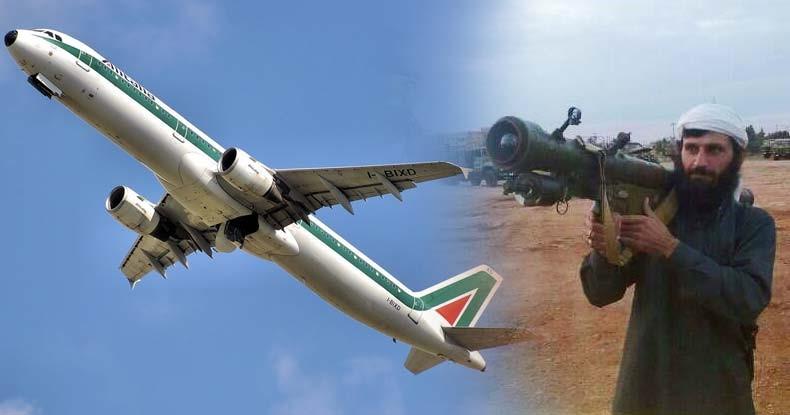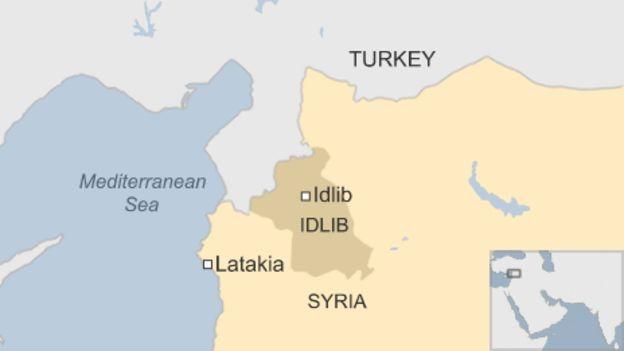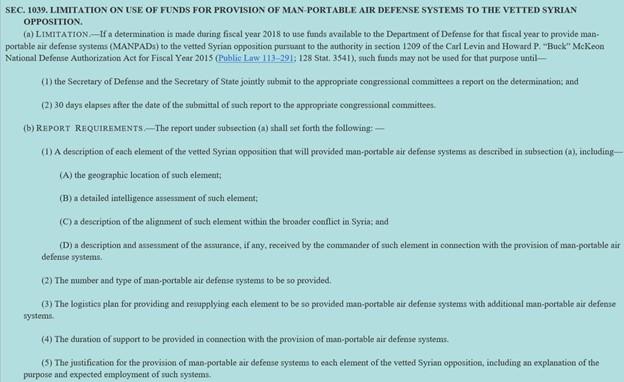By Tyler Durden | Zero Hedge | February 6, 2018
MANPADS are heat seeking shoulder fired missiles capable of hitting targets flying at anywhere between 10,000 and 15,000 feet. Image source: Activist PostAfter the terrorist group Hayat Tahrir al-Sham (HTS), a rebrand of Jabhat al-Nusra, which is the Syrian al-Qaeda affiliate, claimed responsibility for the dramatic downing of a Russian Su-25 fighter jet over Idlib in northwest Syria on Saturday – the first Russian plane downed in Syria since 2015 – a number of analysts have published articles asking the obvious million dollar question: where did al-Qaeda get the portable anti-aircraft missile system used in the attack?
Once such article in Al Monitor speculates on the following: “The three immediate questions that arose from the attack were how the downing was made possible, how the militants acquired the arms and whether there was a bigger-level player behind the attack.”
MANPADS are heat seeking shoulder fired missiles capable of hitting targets flying at anywhere between 10,000 and 15,000 feet.
And Al Monitor seems to answer its own question in the following when listing the array of allied groups now operating under the leadership of al-Qaeda (HTS) – among them groups previously “vetted” and approved to receive advanced weaponry by the CIA (specifically the TOW anti-tank missile):
Dozens of miles of Idlib province are contested among an array of groups, including the terrorist Hayat Tahrir al-Sham (HTS), a rebrand of Jabhat al-Nusra, which was affiliated with al-Qaeda; the Free Syrian Army; and its affiliate Jaish al-Nasr, which is considered a “moderate opposition group” that received weapons from the United States. Minutes after the downing of the Su-25, Alaa al-Hamwi, the military commander of Jaish al-Nasr’s aid defense battalion, claimed responsibility for the attack. Alaa argued that Jaish al-Nasr’s command supplied weapons to protect against the Russian air assault.
Later, however, HTS claimed responsibility for downing the plane.
Though US intelligence and defense officials have long denied that so-called “vetted” groups in Syria were recipients of anti-aircraft systems, rumors to the contrary have been persistent for years. The latest denial came immediately on the heels of Saturday’s Russian jet shoot down, which resulted in the death of the pilot on the ground as he came under fire by jihadists. Pentagon spokesman Maj. Adrian J.T. Rankine-Galloway told Russia’s TASS: “The United States have not provided any of its allied forces in Syria with anti-aircraft weapons.”
The Pentagon spokesman further said, according to RT, that the US-led coalition is currently not engaged in any operations in the area where the jet was downed Saturday, indicating the coalition’s combat efforts are “geographically orientated on the current fight with Islamic State (IS, formerly ISIS, ISIL) in eastern Syria.” Yet the statement clearly avoided any reference to past US programs to arm so-called “moderates” – whether through the secretive CIA program or DoD program. And this is to say nothing of allies like Saudi Arabia who worked closely with US intelligence for years in supplying weapons to anti-Assad militants.
But does anyone remember this? …from The Wall Street Journal all the way back in February of 2014, headlined Saudis Agree to Provide Syrian Rebels With Mobile Antiaircraft Missiles – U.S. Also Giving Fighters Millions of Dollars for Salaries
Washington’s Arab allies, disappointed with Syria peace talks, have agreed to provide rebels there with more sophisticated weaponry, including shoulder-fired missiles that can take down jets, according to Western and Arab diplomats and opposition figures.
Saudi Arabia has offered to give the opposition for the first time Chinese man-portable air defense systems, or Manpads, and antitank guided missiles from Russia, according to an Arab diplomat and several opposition figures with knowledge of the efforts. Saudi officials couldn’t be reached to comment.
The U.S. has long opposed arming rebels with antiaircraft missiles for fear they could fall into the hands of extremists who might use them against the West or commercial airlines. The Saudis have held off supplying them in the past because of U.S. opposition.
And also this March 2014 report from US government-funded Voice of America news:
Saudi Arabia reportedly is offering to provide Syrian rebels more sophisticated weapons, including shoulder-fired anti-aircraft missiles that can take down fighter planes and helicopter gunships. They could be a game changer in the Syrian civil war. Known as MANPADS or man-portable air defense systems, the shoulder-fired missiles are a highly-effective weapon.
Now, Saudi Arabia is offering to supply moderate rebels with these weapons. That could tip the balance on the battlefield.
… President Barack Obama is said to be rethinking U.S. strategy toward Syria. No doubt arming the Syrian rebels will be on the agenda when Obama travels to Saudi Arabia in late March.
Meanwhile, in February 2018 there’s this to consider…
Al-Qaeda controls a strip of land (Idlib province) not far from the Mediterranean coast, and has now clearly demonstrated the capability of shooting down aircraft.
In 2014 a historical first was reached: al-Qaeda established a foothold on the Mediterranean coast after it took the Syrian town of Kessab, but has since been pushed back into Idlib.However, al-Qaeda still remains a very short drive to the Mediterranean coast, with Syrian government territory in between.
MANPADS (“man-portable air-defense system”) have appeared on the Syrian battlefield in recent years in the hands armed opposition groups supported by the West and Gulf states, including various FSA and Islamist factions – some of which, as Al Monitor confirms, operate today in Idlib.
These groups have at various times filmed and demonstrated themselves to be in possession of these externally supplied MANPADS long before last weekend’s Russian jet downing. The portable systems are believed by analysts to have entered Syria in multiple waves via different routes and external sponsors, including old Soviet models shipped out of Libya, Chinese FN-6’s provided by Qatar, and through NATO member Turkey’s porous border with Syria. Some supplies were also likely gained through opposition takeovers of Syrian government storehouses as well as ISIS seizures of Iraqi government bases and equipment.
Most likely, United States intelligence operatives simply allowed its close allies like the Saudis and Turks to introduce MANPADS early on in the conflict to the Syrian battlefield. In this way the US could maintain “plausible deniability” as it is likely doing now after last weekend’s attack.
But a detail which has gone largely unnoticed since the Russian fighter downing is that Congress had already quietly laid the legal framework for US transfer of MANPADS to groups in Syria over a year ago as part of the Fiscal Year 2017 National Defense Authorization Act (the NDAA passed the House and Senate in the opening weeks of December 2016). The leading military news site SOFREP reported the authorization at the end of 2016, and described at the time that “Congress for the first time authorized the Department of Defense to provide vetted-Syrian rebels with anti-aircraft missiles.”
Concerning procedural rules, the NDAA requires that the Secretaries of Defense and State submit a formal request to Congress requesting the transfer of the anti-aircraft missiles systems to Syria, which must include the following according to the SOFREP report:
- A detailed description of each element of the vetted Syrian opposition receiving MANPADS
- The justification for providing those elements with MANPADS
- The number and type of MANPADS provided
- The logistics plan for resupplying approved elements with MANPADS
- The duration of support
And SOFREP included the following observation:
The inclusion of the provision represents a departure from previous versions of the NDAA. The original House bill specifically prohibited the transfer of MANPADS to “any entity” in Syria, while the Senate bill did not address it.
Though there was an attempt in March 2017 to roll back the authorization, nothing appears to have changed regarding MANPADS and Syria in the 2018 NDAA, which was signed into law by President Trump.
Here’s the law authorizing US transfer of MANPADS to Syria as contained in the 2018 National Defense Authorization Act (NDAA):
However, long before this formal NDAA legal framework was put into effect, it appears anti-aircraft systems were already being handed out among Syrian militant groups – again, likely through the Saudis or a third party US ally. In May 2016 we featured the following commentary:
Dr. Christina Lin, a leading scholar on jihadist groups, opens her April 8th commentary at Asia Times: “In a blunder reeking of the fallout caused by supplying Stinger anti-aircraft missiles to 1980s mujahideen in Afghanistan, civilian airline passengers are now under threat from Syrian jihadists armed with portable surface-to-air missiles (MANPADS).
Reports say some American-backed jihadi groups are being equipped with US-made MANPADS. Indications are they’re obtaining these advanced weapons either directly or indirectly from the US or its Mideast allies in connection with a recent escalation in the fighting in Syria.”
And further:
Dr. Lin quotes a Saudi official as saying (in Germany’s Spiegel), “We believe that introducing surface-to-air missiles in Syria is going to change the balance of power on the ground… just like surface-to-air missiles in Afghanistan were able to change the balance of power there.” He was referring there to this in 1979, where Obama’s friend Zbigniew Brzezinski explained why the Americans and the Saudis were supplying SAMs to the mujahideen who became al-Qaeda, and he was also referring to this in 1998, where Brzezinski, when asked whether he thought that arming those fundamentalist Sunnis had been a mistake, said that it certainly was not.
And an unpleasant reminder which bears repeating…
The threat of MANPADS taking out civilian passenger jets is very real, as history proves. The US Department of State counted that 40 civilian aircraft have been hit by MANPADS since the 1970s, which includes the complete downing of 28 civilian airliners resulting in over 800 fatalities. The State Department’s official report on MANPADS and civilian aircraft provides the following partial list of attacks on civilian aviation:
- March 12, 1975: A Douglas C-54D-5-DC passenger airliner, operated by Air Vietnam, crashed into Vietnamese territory after being hit by a MANPADS. All six crew members and 20 passengers were killed in the crash.
- September 3, 1978: An Air Rhodesia Vickers 782D Viscount passenger airliner crash landed after being hit by a MANPADS fired by forces from the Zimbabwe Peoples Revolution Army. Four crew members and 34 of the 56 passengers were killed in the crash.
- December 19, 1988: Two Douglas DC-7 spray aircraft en route from Senegal to Morocco, chartered by the U.S. Agency for International Development to eradicate locusts, were struck by MANPADS fired by POLISARIO militants in the Western Sahara. One DC-7 crashed killing all 5 crew members. The other DC-7 landed safely in Morocco.
- September 22, 1993: A Tupolev 154B aircraft operated by Transair Georgia was shot down by Abkhazian separatist forces, crashed onto the runway and caught fire, killing 108.
- April 6, 1994: A Dassault Mystère-Falcon 50 executive jet carrying the Presidents of Rwanda and Burundi and its French flight crew was shot down over Kigali, killing all aboard and sparking massive ethnic violence and regional conflict.
- October 10, 1998: A Boeing 727-30 Lignes Aeriennes Congolaises airliner was downed over the Democratic Republic of the Congo jungle by Tutsi militia, killing 41.
- December 26, 1998: A United Nations-chartered Lockheed C-130 Hercules transport was shot down over Angola by UNITA forces, killing 14.
- January 2, 1999: A United Nations Lockheed L-100-30 Hercules transport was shot down by UNITA forces in Angola, killing 9.
- November 28, 2002: Terrorists fired two MANPADS at an Arkia Airlines Boeing 757-3E7 with 271 passengers and crew as it took off from Mombasa, Kenya. Both missiles missed.
- November 22, 2003: A DHL Airbus A300B4-203F cargo jet transporting mail in Iraq was struck and damaged by a MANPADS. Though hit in the left fuel tank, the plane was able to return to the Baghdad airport and land safely.
- March 23, 2007: A Transaviaexport Ilyushin 76TD cargo plane was shot down over Mogadishu, Somalia, killing the entire crew of 11.
Source Article from https://uprootedpalestinians.wordpress.com/2018/02/08/how-al-qaeda-ended-up-with-anti-aircraft-missiles-here-is-the-congressional-authorization/
Related posts:
Views: 0
 RSS Feed
RSS Feed

















 February 8th, 2018
February 8th, 2018  Awake Goy
Awake Goy 





 Posted in
Posted in  Tags:
Tags: 
















